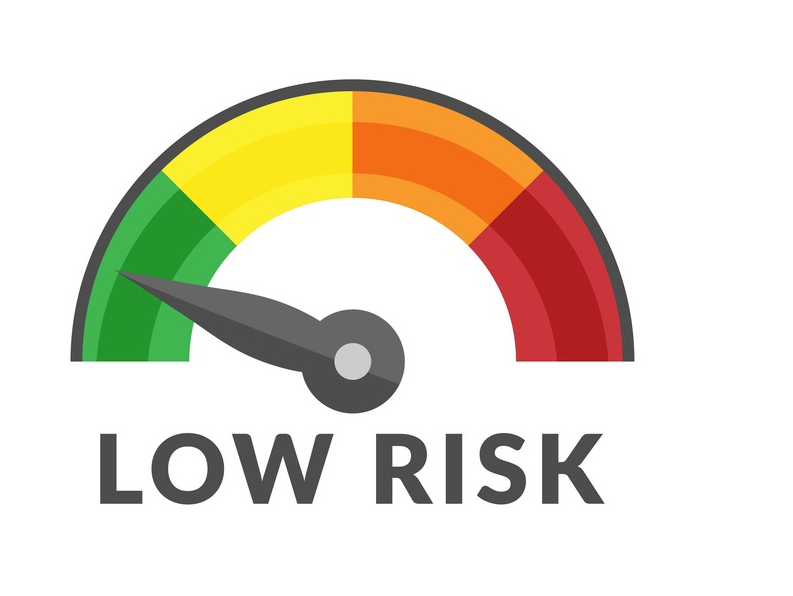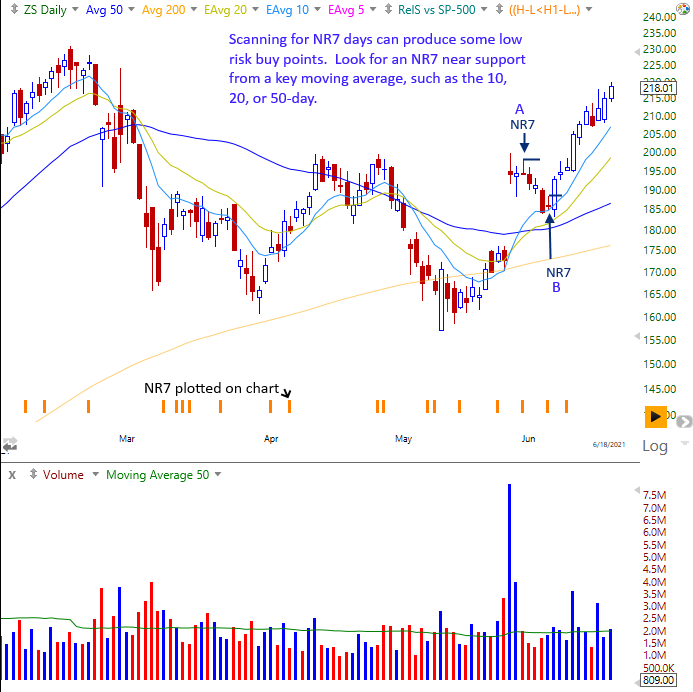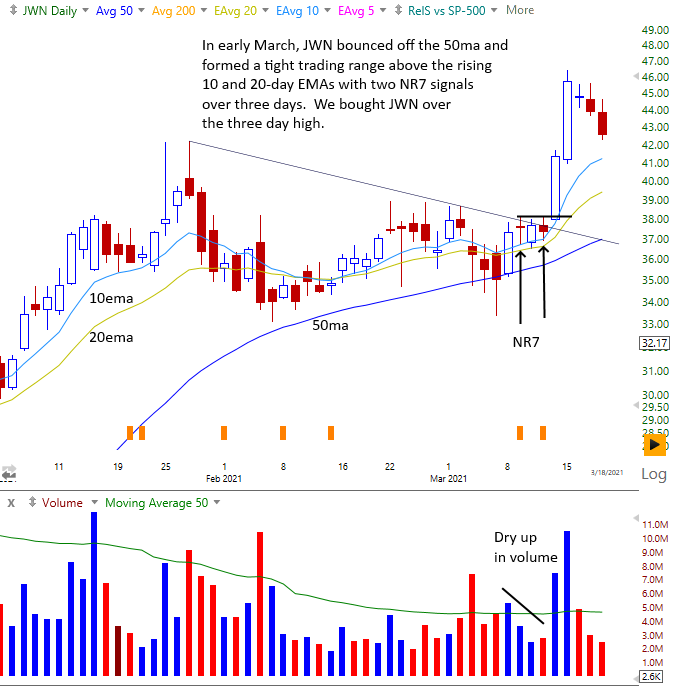
Stock price contractions lead to volatility expansions that can provide you with big winning trades–if you catch them at the right time. Here’s how to profit from these moves with low-risk entry points using the “NR7” indicator.
Through more than twenty years of experience swing trading stocks, we have found one of the most important expressions in trading is that price contraction typically leads to a volatility expansion.
This means that when the price range of a stock tightens up, it is often resolved by a strong move with a pick-up in volatility.
Typically, the longer the price contracts, the greater the price and volatility expansion (in either direction).
Continue reading to learn why the “NR7” indicator is a simple way to spot stocks with significant price contraction that often lead to explosive gains.
How to spot a dry up in price volatility
The Narrow Range 7 indicator (NR7) is used to measure the volatility of a stock.
Specifically, an NR7 day is simply the most narrow trading range of the past seven days (based on the intraday high and low of each day).
An NR7 day can be calculated manually, but we recommend automating your scanning with a program such as the simple, yet powerful TC2000 application.
Below is the exact formula for finding an NR7 day, which you can copy and paste directly in to TC2000:
NR7 day: The formula
H – L < H1 – L1 AND H – L < H2 – L2 AND H – L < H3 – L3 AND H – L < H4 – L4 AND H – L < H5 – L5 AND H – L < H6 – L6
Why use the NR7 indicator?
In swing trading, we look for stocks that have shown an unusual amount of relative strength over a certain period of time.
After the initial rally stalls, we then look for price action to tighten up and form a bull flag type pattern.
The bull flag is a short-term pause in the bullish price action that typically leads to further gains.
We also look for a potential pullback to a key moving average, such as the 10, 20, or 50-day moving average.
We can easily find the best of these bullish pauses and pullbacks using the NR7 indicator.
NR7 days do not automatically trigger buy signals
Before showing you a few actual examples of the NR7 day applied to charts, we need to make one quick, but important point about the indicator…
Not all NR7s are buy signals.
When scanning, you may see a handful of NR7 days that form on the chart, but we are only looking for an NR7 that is near support of a key moving average.
With the MTG trading system, we use the 10, 20, and 50-day moving averages.
How to spot the NR7 day and when to buy
Below is a daily chart of Zscaler ($ZS) that clearly shows how we use the NR7 as a buy signal.
The commentary that follows explains the chart:
First, we set up TC2000 to display the NR7 signal as an orange bar (below the price).
As mentioned above, remember that not all NR7 days signal a buy entry point.
Once we locate an NR7 day near a key moving average, we typically set a buy stop just above the high of the NR7 day.
If the intraday high of the NR7 day is just below the highs of a tight, three-day range, then we place our buy stop above the high of the three-day range.
Point “A” on the chart: The first NR7 day is extended too far above the 10 and 20-day exponential moving averages, making it not an ideal buy signal.
Since the price did not move above the high of the NR7 day, the buy signal was never in play.
Point “B” on the chart: The next NR7 day occurs on a pullback to the 10-day EMA, with support of the 20-day EMA just below.
The moving averages just below the price provided a low-risk buy entry, which triggered when the price moved above the high of the NR7 day in the following session.
NR7 buy entry leads to a +20% gain in two days
Next is a daily chart of Nordstrom ($JWN), which shows an NR7 day that generated an official buy signal in the model portfolio of The Wagner Daily, our nightly stock trading report.
This winning swing trade led to a quick gain of +20% gain for subscribers in just a few days, so let’s take a closer look:
$JWN exploded higher in late 2020, then stalled at the $40 level and formed a base of support.
While consolidating, notice the price bounced off major support of the rising 50-day moving average in the first week of March 2021.
It was also the first touch of the 50-day moving average after an explosive move, which is often a buy signal in itself.
On March 8, the price rallied off support of the 50-day MA on increasing volume (accumulation).
That initial move higher was followed by a few days of tight-ranged price action, which produced two NR7 days above the 10 and 20-day exponential moving averages.
The first NR7 day could have led to a buy entry, but the second NR7 was too good to pass up–especially with volume drying up (a bonus bullish signal).
We alerted Wagner Daily subscribers that we were buying $JWN on March 12, as the price rallied above the highs of the tight, three-day range.
As shown on the chart, this ideal buy entry led to a quick gain of +20% move in just two days.
Why the NR7 day works so well
In stock trading, simple strategies often produce the best results.
In a bull market, one of the most consistent winning techniques is to simply look for an explosive move up, then wait for price to contract.
When the price action contracts, the NR7 indicator helps determine your most ideal, low-risk buy entry point.
Since a stock may generate numerous NR7 signals, always focus on lower-risk entries trading near their key moving averages (10, 20, and 50-day).
As you become more experienced with the signal, the NR7 can be reduced to an NR4 day.
The NR4 indicator will alert you to more potential buy signals, but will allow you to catch a few more lower-risk buy points than the NR7.
At Morpheus, we only use the NR4 on an extremely select group of A-rated stocks–otherwise it can be overwhelming.
Scanning for NR7 days
The easiest way to scan for NR7 and NR4 days is by copying and pasting the code above into the TC2000 platform.
We also suggest using some sort of momentum filter, such as Relative Strength ranking or Biggest Gainers over a month or quarter.
Adding an additional filter to your scan results will help limit the number of potential buy signals to increase your odds of finding the next big winning trade.
You may also subscribe to our flagship swing trading report, where we already do your “heavy lifting” to find the best stock trade setups with exact entry, stop, and target prices every day. Choose the Wagner Daily PRO version to also receive exclusive access to Swing Trader Chat for additional trade ideas and ongoing trader education.
If you have any questions about how to set up and/or use the NR7 indicator, just drop us a line and we will help you out.
Good luck and have fun with your scanning!


